
Everything You Want To Know About Princess Diana’s Wedding Dress, Since It Barely Appeared In “The Crown”
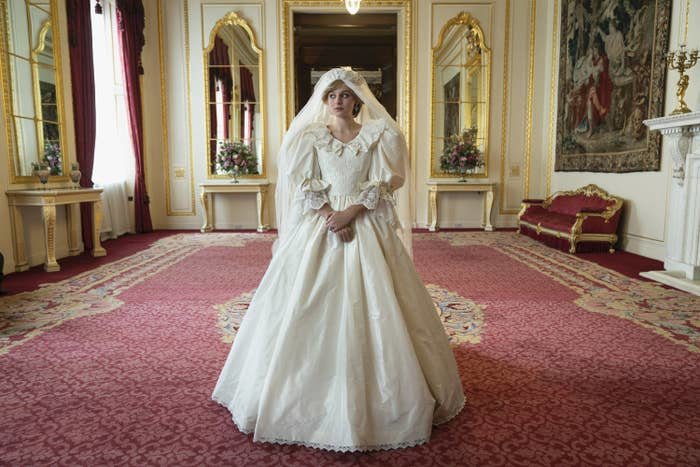
Des Willie / Des Willie/Netflix
Season 4 of The Crown has been winning rave reviews, not only for its acting but for the incredible attention to detail in the show's costumes.
And, of course, the biggest costume piece in this season was the gown worn by Princess Diana on her wedding day on July 29, 1981.
In an interview with the Los Angeles Times, costume designer Amy Roberts revealed that she and her team had to get permission from the original wedding gown's designers, Elizabeth and David Emanuel, to reproduce the dress for the show. Roberts consulted with David on the fabric, and he had shared some of his original designs — but she said that he had encouraged her to "have fun with the replica rather than obsessing over the details."
"He wasn’t precious about it or neurotic about it. That released us from any fear,” Roberts said. “We just went for the feel of it, the look of it, the size of it. Big sleeves, big frills. We didn’t get too stressed. Maybe there’s 201 pearls and we’ve only done 200.”
In a behind-the-scenes featurette released earlier this month, Roberts said that the wedding dress took 14 weeks and five "long" fittings to make. However, despite all of that work, the gown is shown for only approximately 27 seconds in the last moments of Episode 3, "Fairytale."
Since the show dropped on Nov. 15, many fans have expressed disappointment with the iconic gown's brief appearance, especially as actor Emma Corrin is featured prominently wearing the dress in the show's promotional materials.
The cast and crew of The Crown have spoken about the decision to cut the so-called wedding of the century from the show.
"We never re-create things just for the sake of re-creating them. I think if we do re-create a scene — like the engagement scene, for instance, when they do the announcement — it has to be because it's linked to something that the characters are going through. It has to be part of the story. It has to further the plot, basically," Corrin said in an interview with the Hollywood Reporter. “The wedding scene, you can YouTube it and you could be watching it in 10 seconds, so I don't think there'd be any point in us re-creating it."
Roberts has said that she was fine with her masterpiece's brief appearance onscreen. "It’s there and it’s gone,” she told the LA Times. “It’s a brilliant way to deal with it. You don’t need to bang on about it, do you?”
However, since I am a public service journalist and never need an excuse to write about the royal family (sign up for my newsletter, The Royal Tea, if you're into that sort of thing), I’ve decided it’s my duty to write a story with all of the details about Diana's wedding dress that The Crown decided not to include.
So get your tea and crumpets and settle in for this fashionable walk through history.
The gown’s designers, the Emanuels, were a young and relatively unknown husband-and-wife team with a small boutique in London's Mayfair district.
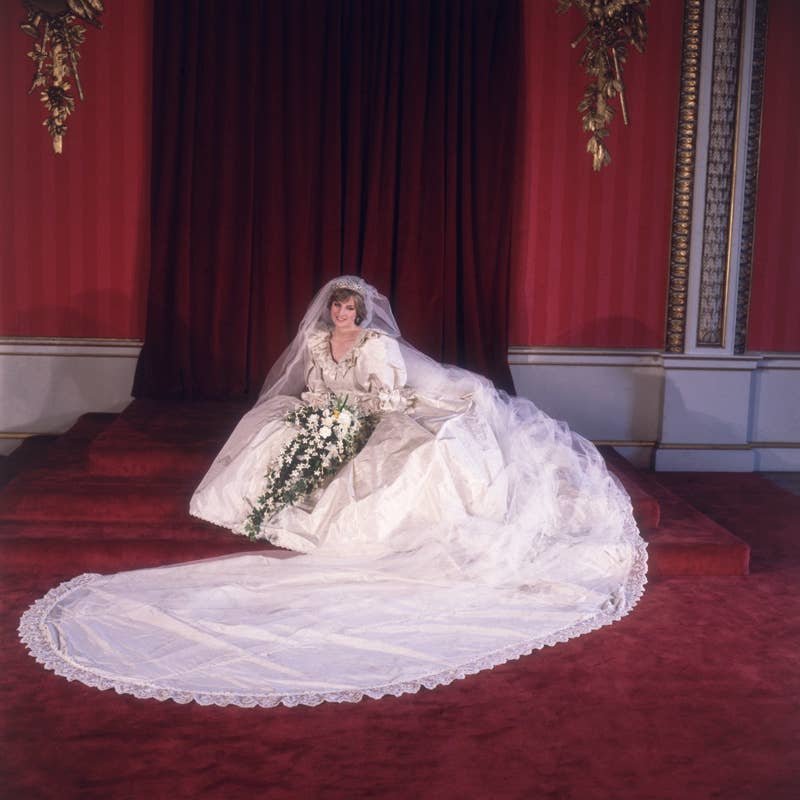
Diana — then Lady Diana Spencer — personally chose designers David, 29, and Elizabeth, 27, because she liked a chiffon blouse they'd made for her first official royal portrait (which was photographed by Lord Snowdon, Princess Margaret's husband from 1960 to 1978).
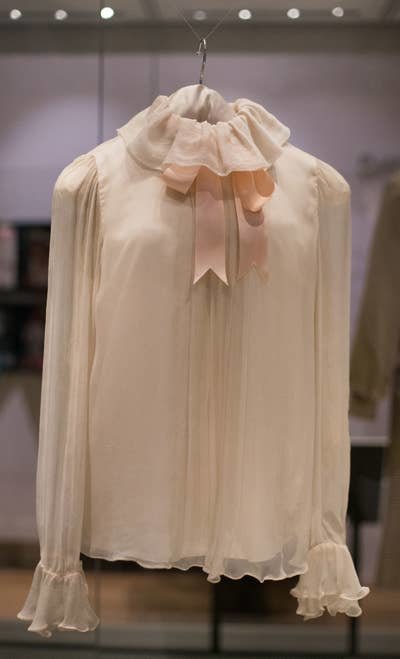
"One day I was in a fitting in the showroom doing somebody's wedding dress and the phone kept ringing, and I was getting really mad because nobody would answer it," Elizabeth said in a 2001 ABC interview.
"Finally, I got on the phone ... and it was Diana, and she actually — I mean, it was unbelievable — she said, 'Would you do me the honor of making my wedding dress?' And I can still feel the tingles going up my arm.'"
"It was just such a simple statement," Elizabeth said in another interview. "In fact, she asked if we would like to do her dress. You know, as if we might say no."
Unlike the more recent royal weddings, where the designers of the dress and every single detail about it have been kept secret until the moment the bride arrives at the ceremony, Buckingham Palace announced that the Emanuels had won the job on March 10, 1981.
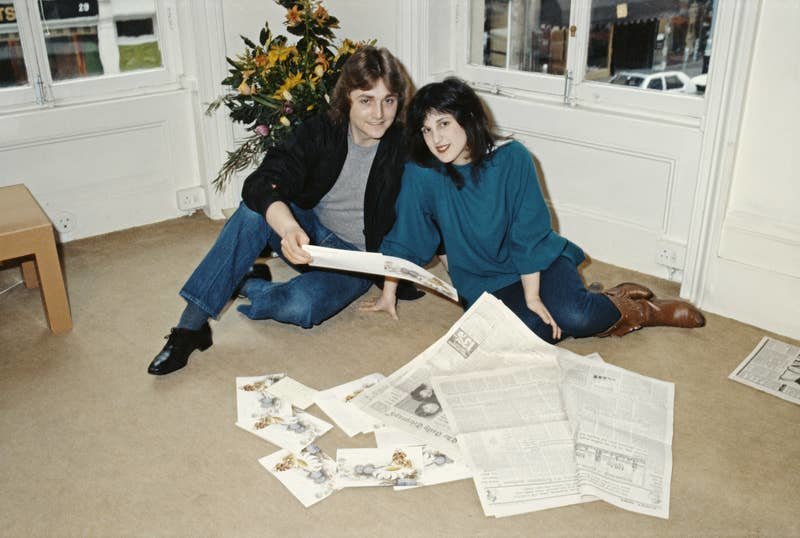
The news was made public the day after Diana's first official royal engagement as Prince Charles' fiancé, to which she had worn a strapless Emanuel evening dress that she had picked out on her first trip to the store and which subsequently made headlines around the world.
Diana told the Emanuels that she wanted to look like a "real, live fairy-tale princess" on her wedding day, and she worked closely with them to design her dream wedding dress — without any guidelines from Buckingham Palace.
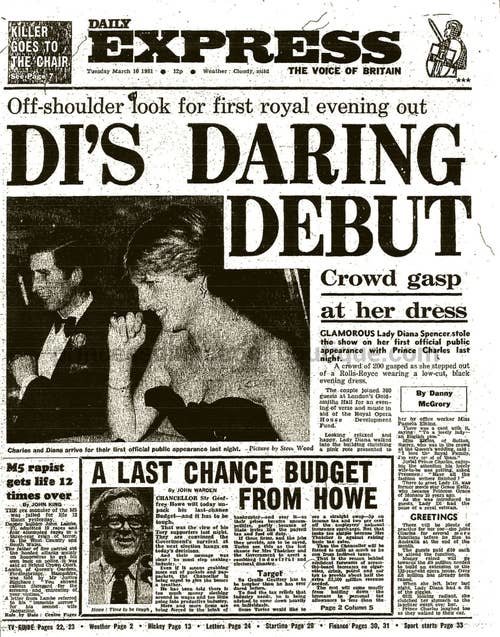
"No red tape, no pomp and circumstance," David said in an NBC interview in 2011. "Lots of sitting on the carpet, talking to Diana. And then we did some research. We went through the royal brides."
They decided on a romantic design full of poof and flounces and frills. "We wanted drama, darling, drama," David said.
From the beginning, Diana and the Emanuels knew they needed one specific feature on the gown: an enormous train to follow her down the aisle of St. Paul's Cathedral.
"[The cathedral] was just aching for an epic dress," David said. In their research, the Emanuels discovered that the longest train on any royal wedding dress had been 20 feet. When they told Diana this, she instructed them to make a 25-foot-long train for her dress and an even longer veil.
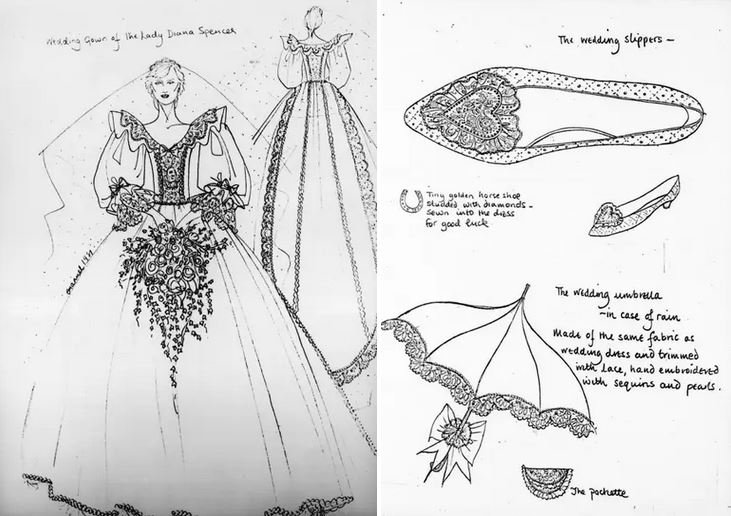
Let's get into the specifics.
The gown, made from 41 yards of fabric, was created using only British materials. The silk was spun specifically for Diana’s dress by worms at the UK's last silk farm, and the lace was made using an antique machine in a Nottingham factory that would also supply the material for the wedding dress for Catherine, Duchess of Cambridge, nearly 30 years later.
The dress and the veil — made from the same British silk — were hand-embroidered with tens of thousands of mother of pearl sequins, as well as actual pearls.
An umbrella was made out of the same materials as the dress (and also hand-embroidered) just in case the wedding day proved to be rainy.
Diana's wedding shoe designers, Clive Shilton and Julie Smith, were only shown the materials the Emanuels were using, not the design of the dress itself. Without much information to go on, they created a pair of low-heeled ivory slippers with hand-embroidered sequins and pearls to (hopefully) match the dress. The soles of the shoes were etched with gold and included a "C❤️D" emblem.
Like many brides, Diana made sure that she would walk down the aisle with the traditional "something old, something new, something borrowed, and something blue."
The old: the antique lace on the bodice of the dress, which originally belonged to Queen Mary, Queen Elizabeth's grandmother. The new: the wedding dress itself, made from that custom silk. The borrowed: the Spencer family tiara. The blue: a small bow that the Emanuels stitched into the waistband of her dress.
The Emanuels also stitched one additional charm into Diana's dress: a tiny 18-karat gold horseshoe with diamonds, for luck.
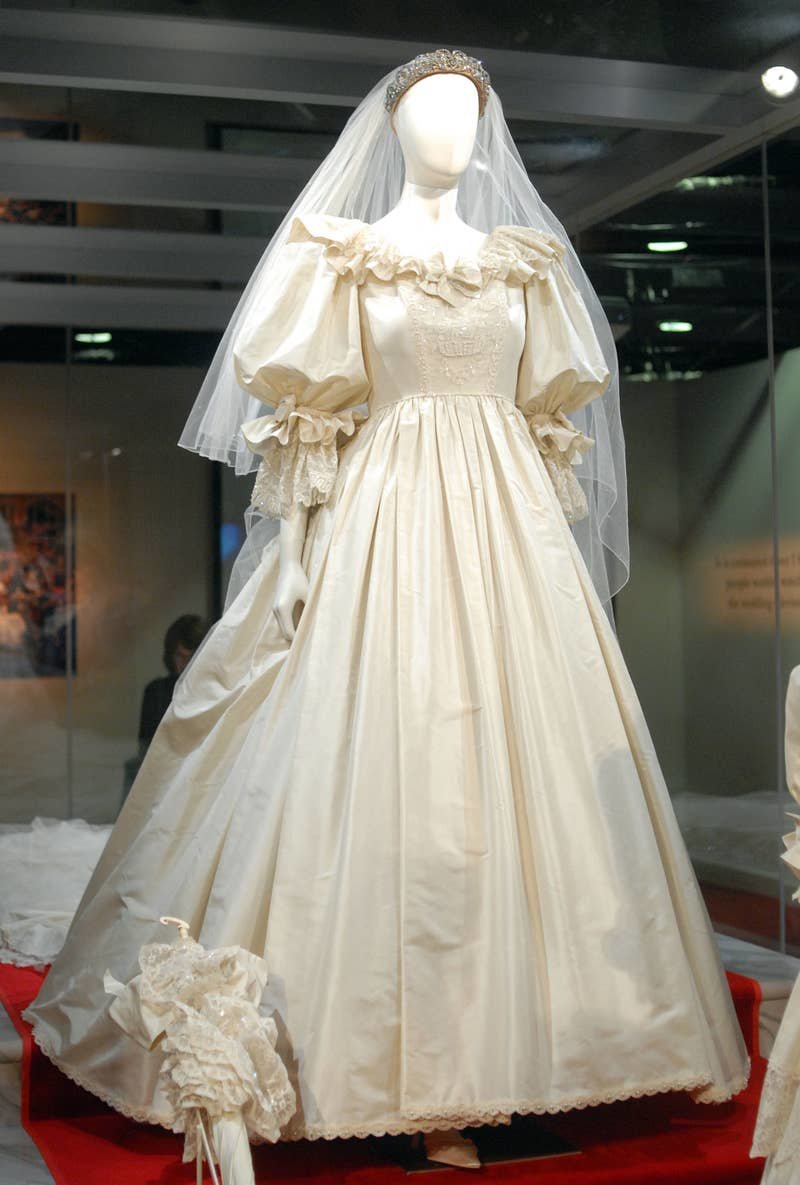
Since the frenzied, Diana-obsessed press knew that the Emanuels were making the dress, the designers had to take extreme steps to keep it under wraps during the months leading up to the wedding.
First, they stopped taking new commissions and gave Diana a code name — Deborah — to keep the time and dates of her fitting appointments secret.
Knowing that reporters would be going through their boutique's garbage for clues, they purposefully ordered and threw out thread and fabric of a variety of different colors.
"We were really, really careful about security," Elizabeth said in the 2001 ABC News interview. "So much so that we organized for a big, metal safe to be delivered to the studio. It was so big, it wouldn't go through the front door. And we had to hoist it up through the windows. Every night, we would lock the dress up in there. And we had two security guards, Jim and Burt. And they had to guard it.”
After a London tabloid attempted to get the design by offering one of their employees a $65,450 bribe, the Emanuels started lying to reporters in an attempt to throw them off the scent, saying that they had created three separate wedding dresses in case the style of one of the dresses leaked. (They admitted their hoax to the AP a few hours after the wedding.)
The secrecy paid off. By the day of the wedding, the dress had only been seen by 14 people.
But secrecy wasn't the only problem facing the young designers. As depicted in The Crown, the stress of Diana’s new position and worries about her future husband's fidelity triggered her bulimia, resulting in rapid weight loss and leaving the Emanuels scrambling to adjust the dress to her shrinking frame.
In an interview with journalist Andrew Morton — who secretly collaborated with the princess to write the explosive tell-all biography Diana: Her True Story in 1992 — Diana said that in the time between her first fitting in February and her wedding day in July, her waist had shrunk by 5 and a half inches.
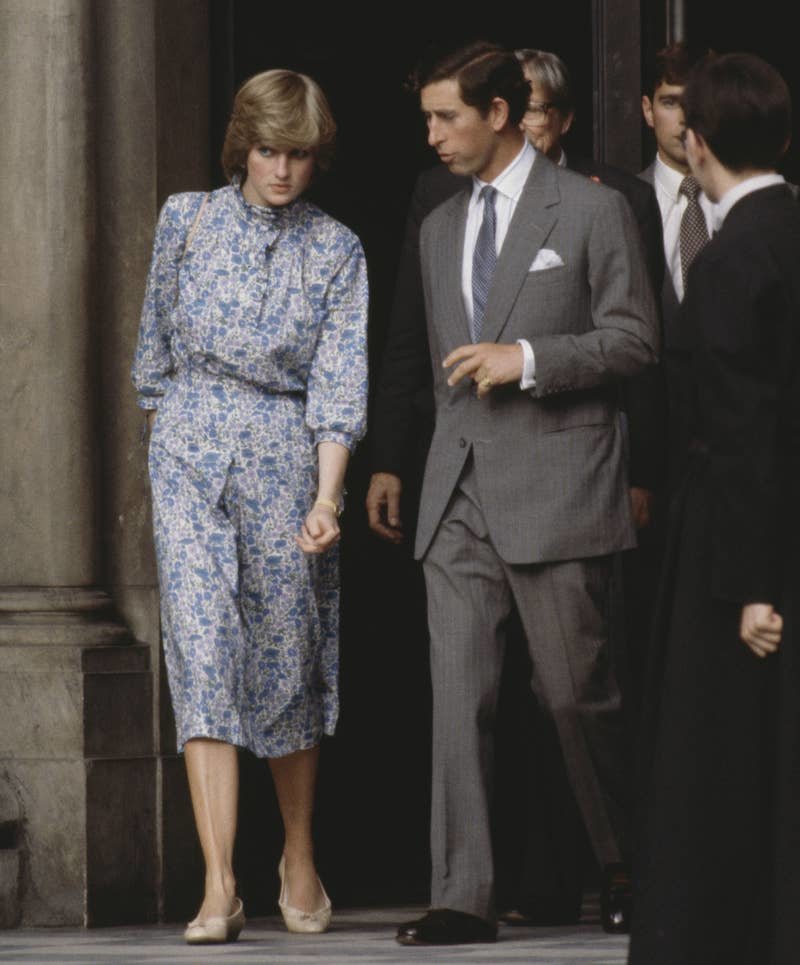
On the day of the wedding, the designers were on hand to get Diana into the gown. And despite what you may have heard, she did not have to be sewn into it.
The princess-to-be was to ride in a carriage with her father, John Spencer, the 8th Earl Spencer from Clarence House, to St. Paul's Cathedral. So the Emanuels had to figure out a way to fit two people and the enormous dress into the carriage.
"We did have a rehearsal and we got her into the carriage with a big petticoat, and that wasn't a problem," Elizabeth said in the 2001 ABC News interview. "But on the day, well, you know, her father, Earl Spencer, is quite a large man, and the carriage is quite small."
"We finally got her into the carriage ... but then, of course, you've got the train behind," David said in a 2006 interview. "So we're literally folding the train like one folds sheets. You know, bedsheets? At the end, it was almost like stuffing it all in there to get it in."
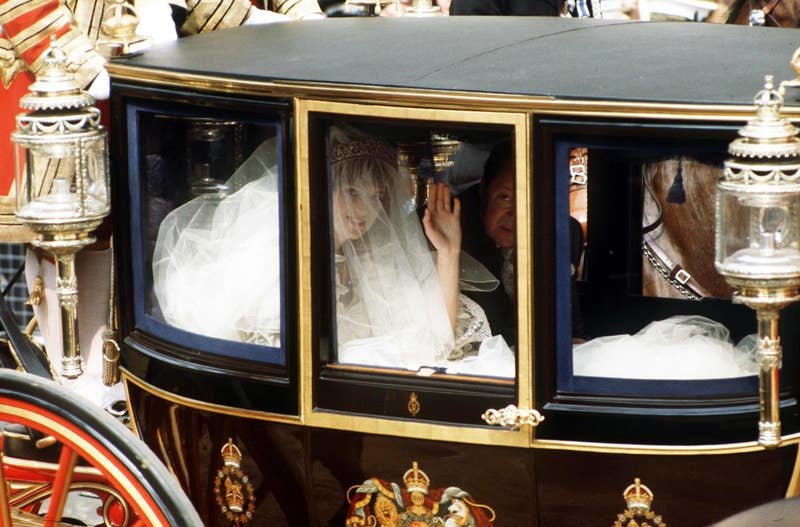
Royal weddings are planned with military precision for practical as well as protocol purposes — the exact times that the Queen, Charles, and Diana would each arrive at St. Paul's Cathedral were written in the official order of service.
The plan had always been to keep the details of the wedding dress secret until the moment that Diana stepped out of the carriage — but as soon as she did, the world's media needed to give those details to the 750 million people in 74 countries who were watching the ceremony on television.
This was 1981, remember, so no tweets or emails. Instead, Buckingham Palace had given the details to reporters in sealed envelopes on the morning of the wedding, under strict instructions that they were not to be opened until Diana's arrival at the cathedral at 10:55 a.m.
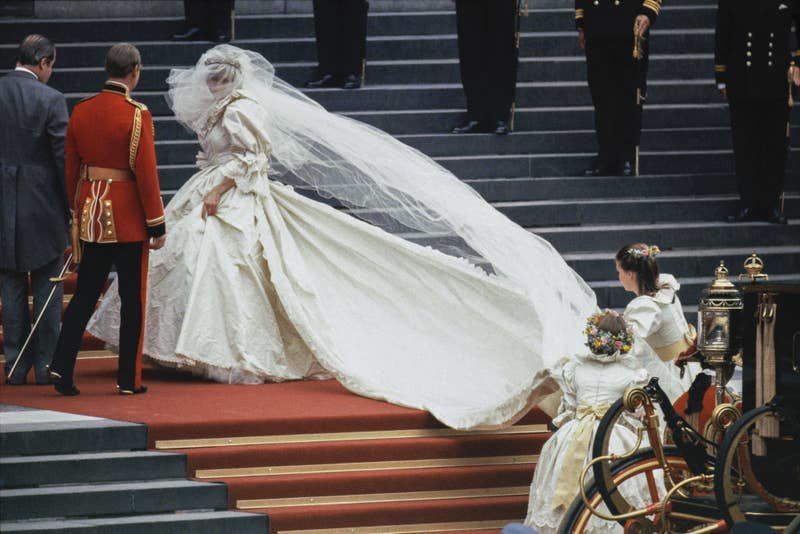
When Diana stepped out of the carriage, however, the designers’ first reaction was panic rather than pride.
"We saw her coming up the steps. She came in through the doorway," Elizabeth recalled in a 2006 interview. "And we did notice that the dress had got more creased than we had thought. Because we knew it was going to get a bit crumpled, and we did go, 'Oh my god.'"
David added, "But confidently underneath all that, we had developed a very heavy weight of taffeta, so I knew that — we knew — once you fluff it out, spread it out, air it, it will all go back into its natural folds."
Fortunately, as you can see in the official wedding broadcast, they were both on hand to fix the damage before Diana began her walk down the aisle.
Regardless of your opinion about the dress, you have to admit that the Emanuels nailed the dramatic train effect that they were going for in the original designing process.
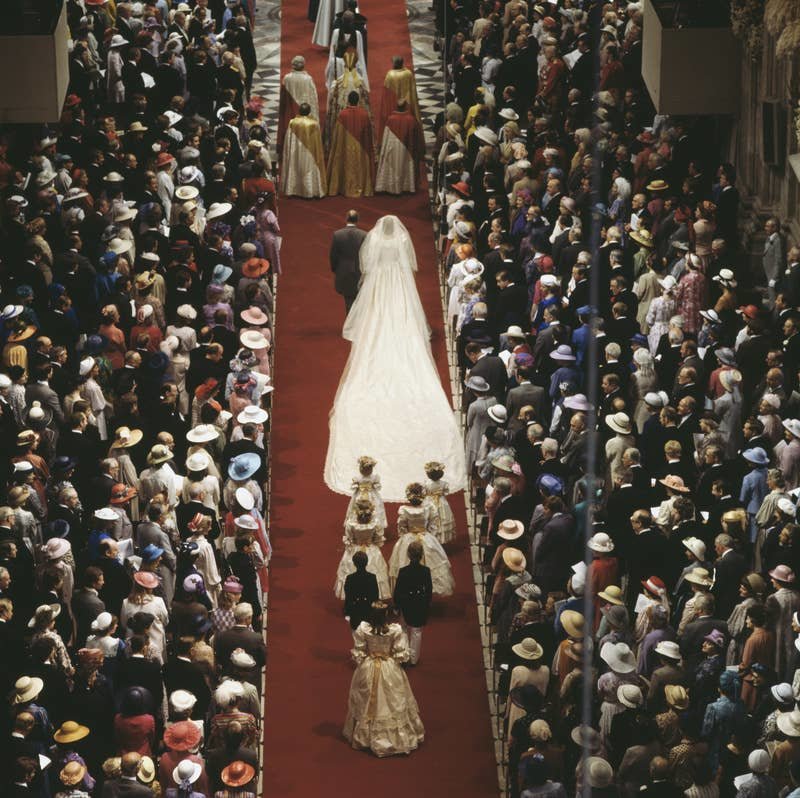
In an interview after the ceremony had finished, the Emanuels said that they had been worried that Diana's groom wouldn't like the dress (like the rest of the world, he had no idea what it would look like).
"The princess was very pleased with it, so obviously we were too," David said. "We were afraid Charles might look down the aisle and not like what he saw, but in fact he told us he liked it very much."
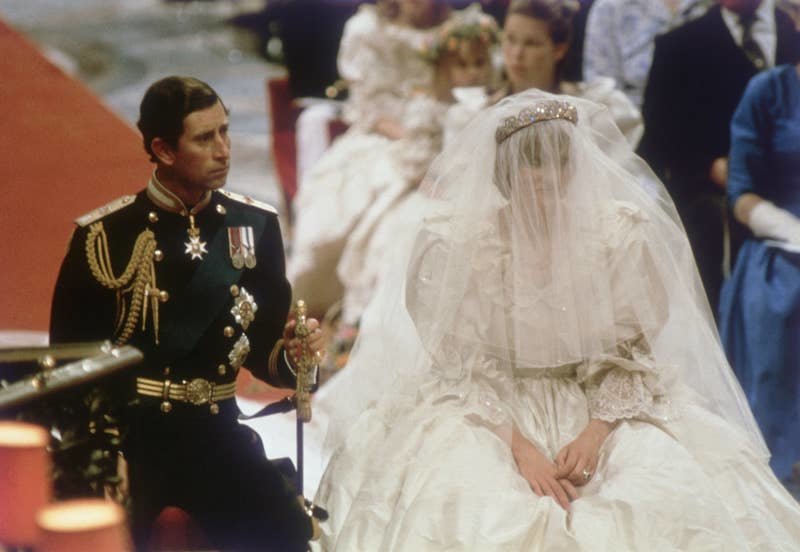
When the couple stepped into a side room to sign the marriage register, Diana's makeup artist Barbara Daly was on hand to freshen her up — and to cut away the veil's blusher.
When the wedding ceremony ended, Diana and Charles waved at the adoring crowds as they headed back to Buckingham Palace for their official photographs, and the Emanuels could finally breathe a sigh of relief.
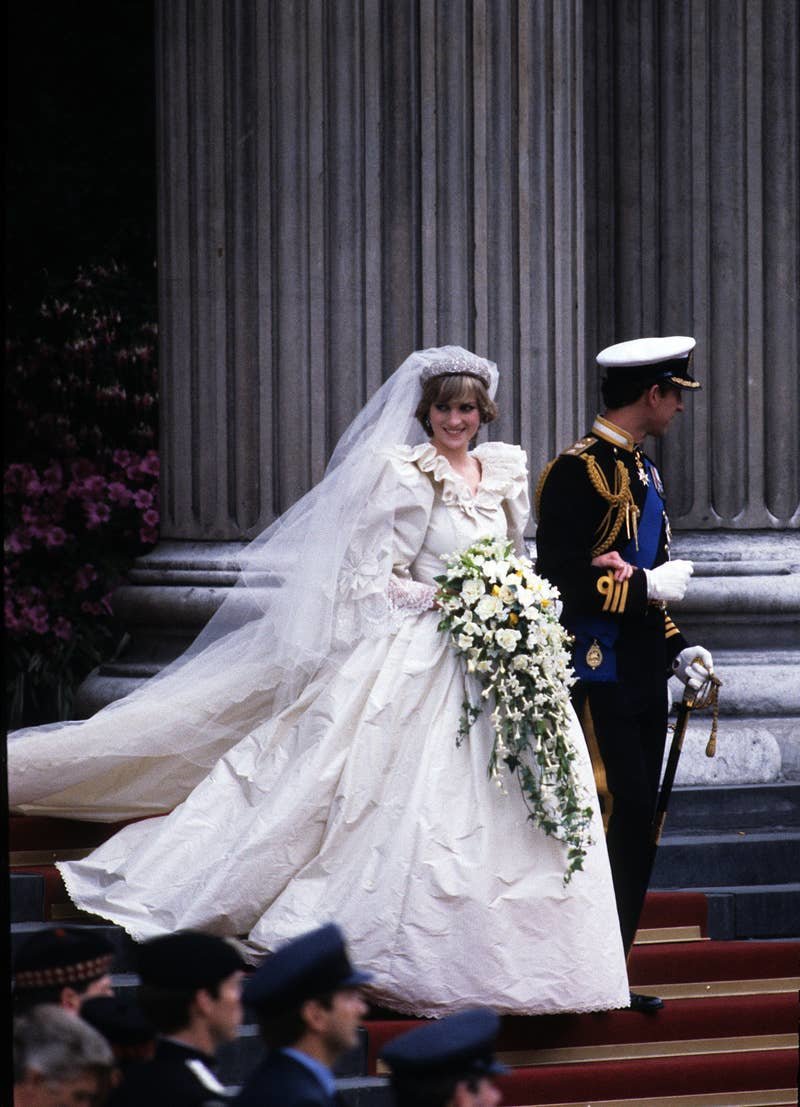
However, later that day, the designers received an unexpected telephone call.
"On the evening of the wedding when everybody'd gone home, Dave and I were sitting alone in our studio, we got a phone call and it was Diana," Elizabeth said in a 2001 interview.
"We sort of were very depressed after the wedding. You know, it was postnatal depression, but she actually took the time to phone us up and thanked us for making her feel so beautiful."
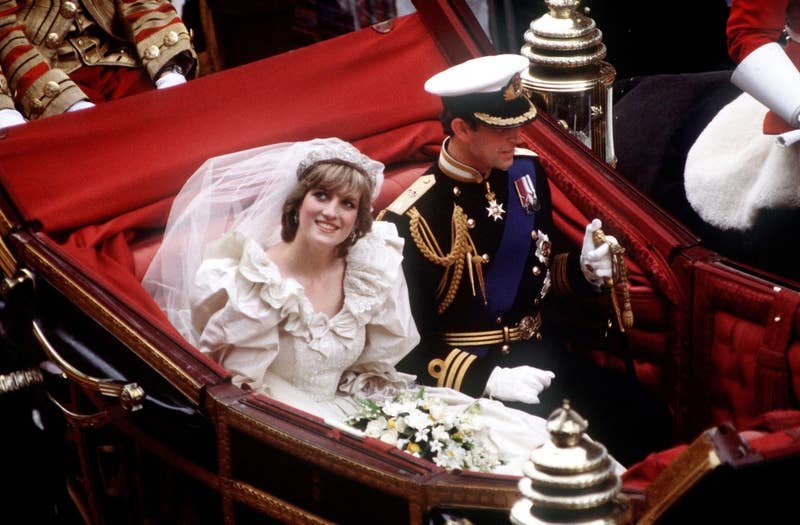
The Emanuels designed many other outfits for Diana over the years, including the ensembles for her and Charles' 1986 tour of the Gulf states.
The wedding gown was on display at Kensington Palace for a few years, but was removed for cleaning in 1993 and never returned.
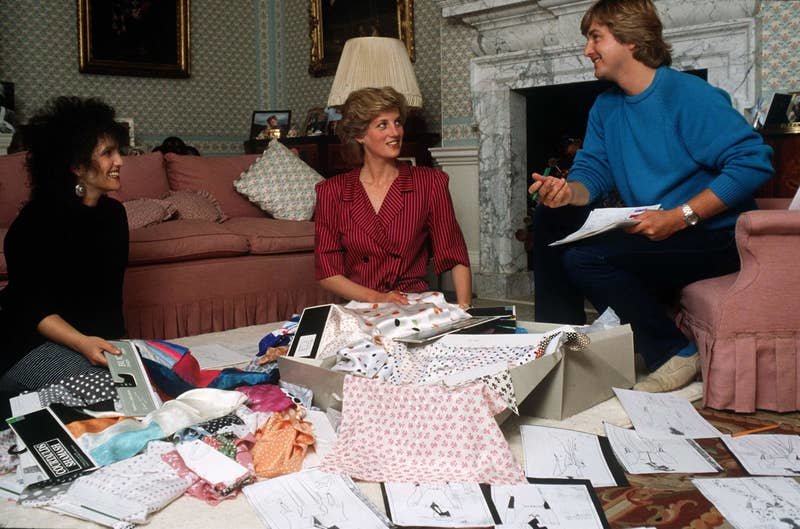
After Diana's death in 1997, the dress began a second life.
In 1998, Diana's brother, Charles Spencer, the 9th Earl Spencer, opened a museum at the family’s Althorp Estate in celebration of her life. The six-room exhibition, dubbed Diana: A Celebration, featured a wide range of artifacts from Diana's life, from family photographs and report cards to some of her most iconic dresses — and her wedding gown was the centerpiece of the collection.
"It's a series of rooms which really put Diana's life in context," Charles told Larry King in an interview.
For 16 years, from July 1, 1998, Diana's birthday, to Aug. 30, 2014, the day before the anniversary of her death, the museum would be open to the public. Beginning in 2002, the exhibit made regular trips around the world for temporary display. Proceeds from ticket sales were donated to the Diana, Princess of Wales Memorial Fund; by the time the exhibit closed, it had raised more than $1.6 million for charity.
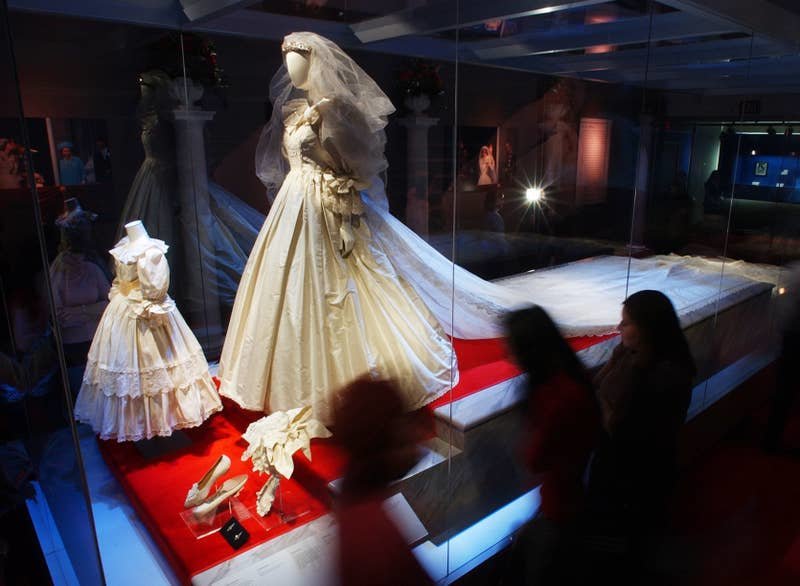
Why did it close at all? Diana's will stipulated that all of her possessions be returned to her sons when Prince Harry turned 30 on Sept. 15, 2014. So, more than 150 personal items that were part of the exhibition were eventually turned over to Princes William and Harry.
The current whereabouts of the dress are not publicly known, and it remains to be seen whether it will ever be on display again.
For now, at least, we have the Crown version.











